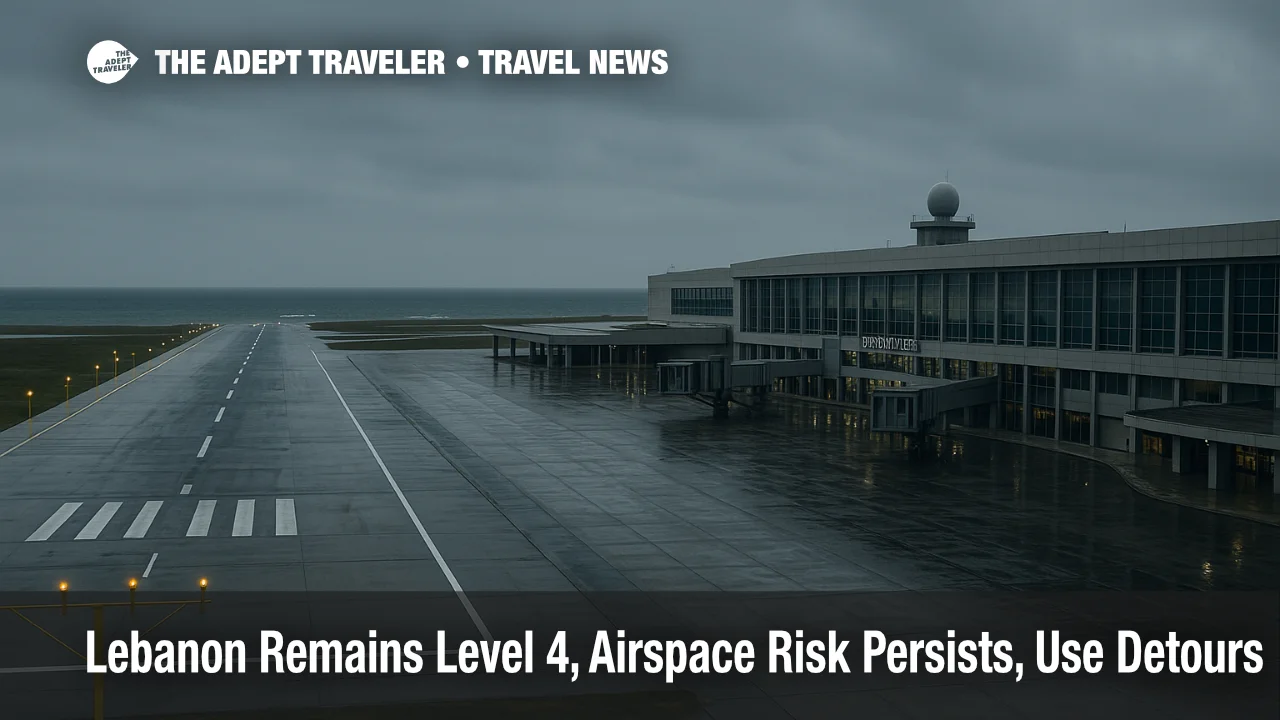Lebanon Remains Level 4, BEY Airspace Risk Persists, Use Detours

Key points
- The U.S. State Department keeps Lebanon at Level 4 Do Not Travel, noting reduced commercial capacity and security constraints
- EASA warns of high risk across Lebanon's FIR, allowing BEY operations only with approaches from the sea and departures over the sea
- Beirut flights are operating on a limited basis, led by MEA with regional links via Doha, Dubai, Cairo, Amman and Istanbul
- Risk briefings highlight GPS spoofing and potential short-notice airspace restrictions affecting routings near Lebanon
- Travelers with essential movement should consider detours via Amman or Larnaca and avoid itineraries that overfly Syria
Impact
- Plan Detours
- Book itineraries via Amman (AMM) or Larnaca (LCA) and connect onward when conditions permit
- Check Routings
- Avoid tickets that overfly Syria and confirm BEY approaches are sea side per carrier procedures
- Build Buffers
- Allow extra connection time and monitor airline alerts for short-notice reroutes or holds
- Document Readiness
- Carry ID and enroll in STEP if already in Lebanon to receive security and consular updates
- Refunds And Changes
- Use flexible or refundable fares and review each carrier's change policy before purchase
Lebanon remains at Level 4, Do Not Travel, per the U.S. State Department on November 6, 2025. The advisory cites crime, terrorism, civil unrest, kidnapping, and the risk of armed conflict, and it notes that commercial flights are available only at reduced capacity. Travelers should avoid non-essential trips and, if movement is unavoidable, plan on detouring through Amman, Jordan, or Larnaca, Cyprus, rather than flying direct to Beirut (BEY) or overflying high-risk corridors.
Beirut operations today
European regulators continue to flag Lebanon's Flight Information Region as high risk. EASA's conflict-zone bulletin explicitly limits permitted operations to approaches that start from the sea into Beirut International and departures that end over the sea, reflecting de-risked coastal profiles to keep aircraft away from inland threat vectors. Airlines must monitor conditions and conduct operator risk assessments for each flight.
Despite the security context, Beirut-Rafic Hariri International Airport remains open, with a constrained schedule visible on the official arrivals board. Carriers reflected on the official feed include Middle East Airlines, Emirates, Qatar Airways, Egyptair, Royal Jordanian, and others, indicating a primarily regional service pattern with selective long-haul links.
MEA, Lebanon's flag carrier, continues to publish schedules and day-of flight status, but seats can be limited and timings may shift around ATC or security restrictions. Travelers should verify specific flights on MEA's schedule and status pages and cross-check routing to ensure compliance with sea-approach procedures.
Latest developments
Independent risk trackers highlight persistent hazards around the Lebanon FIR, including the potential for rapid airspace closures during regional flare-ups and a notable risk of GPS spoofing that can complicate navigation and approach set-ups. This aligns with State Department language warning that some flights to and from Beirut may overfly Syria, which carries additional risk. Together, these factors argue for conservative planning and flexible tickets.
Analysis
Background
A Flight Information Region, FIR, is the block of airspace a state controls for air traffic services. When regulators issue conflict-zone advisories, they often prescribe specific procedures that reduce exposure. In Lebanon's case, EASA's allowance for "approach from the sea, departure over the sea" keeps aircraft over water on the arrival and initial departure segments, reducing time spent over potentially contested inland areas.
Traveler choices
If you must travel, treat BEY as conditional and plan alternates. For many itineraries, the cleanest detours are via Queen Alia International Airport in Amman, which has broad regional connectivity on Royal Jordanian and partners, or via Larnaca International Airport in Cyprus, which offers dense European links and frequent connections onward to the Middle East. Both airports publish real-time flight information to support same-day replans.
Given the State Department's Level 4 posture, travelers already in Lebanon should maintain contingency routing, keep documents handy, and enroll in the Smart Traveler Enrollment Program, STEP, for alerts. Anyone ticketed to BEY should check with the airline that approaches remain sea-side and verify whether the planned routing avoids overflight of Syria, then rebook through AMM or LCA if needed.
Final thoughts
The U.S. Level 4 Lebanon advisory remains in force, and EASA continues to treat Lebanon's FIR as high-risk with coastal procedures into BEY. Until the risk picture improves and schedules stabilize, the most reliable plan is to avoid non-essential travel and to route via Amman or Larnaca with flexible fares that accommodate short-notice changes.
Sources
- Lebanon Travel Advisory, Level 4, U.S. Department of State
- Beirut-Rafic Hariri International Airport, Real-Time Flight Info
- EASA Conflict Zone Bulletin 2025-02-R2, Middle East Airspace
- SafeAirspace Lebanon, OLBB/Beirut FIR Risk Summary
- MEA, Flight Schedule
- Queen Alia International Airport, Flights
- Hermes Airports, Larnaca Flight Information
